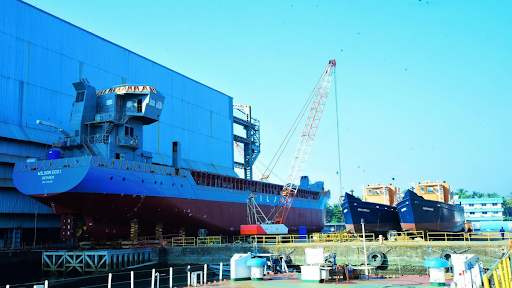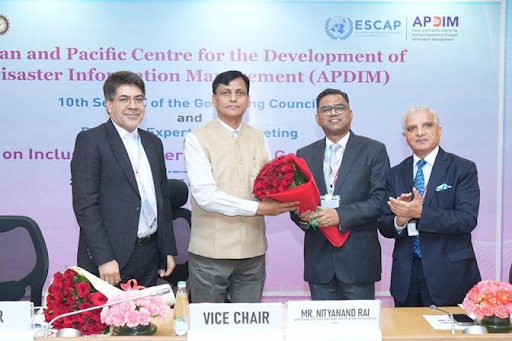



The India-Norway 'Green Maritime Partners' initiative unites India’s Sagarmala-driven maritime ambitions with Norway’s zero-emission expertise. Centered on R&D, green finance, and skill-building, it advances electric, hydrogen, and green ammonia shipping, exemplifying North-South cooperation for a sustainable, decarbonized Blue Economy and global maritime future.

Copyright infringement not intended
Picture Courtesy: THEHINDU
India and Norway are collaborating to advance sustainable green maritime practices, leveraging Norway's low-emission expertise and India's shipping industry to decarbonize the sector.
|
Read all about: INDIAN-NORWAY RELATIONS |
It is a bilateral commitment between India and Norway to promote sustainable practices and technologies in the maritime sector.
This partnership builds upon existing dialogues, such as the India-Norway Joint Task Force on Blue Economy for Sustainable Development, established in 2019.
The initiative focuses on:
Decarbonization of shipping
Exploring and implementing solutions for reducing greenhouse gas (GHG) emissions from vessels.
Green technologies
Facilitating the development and adoption of alternative fuels (e.g., green hydrogen, ammonia, methanol), energy efficiency measures, and digital solutions for ports and ships.
Skill development and technology transfer
Enhancing capabilities and sharing expertise in green shipbuilding, ship recycling, and maritime operations.
Sustainable ocean management
Addressing broader aspects of the blue economy, including marine pollution and ocean health.
Decarbonizing Global Shipping
The International Maritime Organization's (IMO) 2023 GHG Strategy sets ambitious targets for international shipping:
Bilateral cooperation between India and Norway is strengthening and supporting the industry to reach these global goals.
Economic Stake in Green Shipping
The Indian economy relies heavily on its maritime sector, which handles approximately 95% of trade by volume and 70% by value. (Source: PIB)
Achieving India's 2047 developed nation goal and managing global seaborne trade requires green shipping for economic growth and competitiveness.
Norway's Leadership in Sustainable Maritime Solutions
Norway excels in low/zero-emission, digital maritime, and ship retrofitting, aiming for the world's most efficient, eco-friendly coastal shipping via its "Green Coastal Shipping Programme."
Synergistic Partnership
Norway and India are collaborating on green solutions. Norway contributes green technology and expertise (electric ferries, hydrogen, ammonia fuels), while India provides a large market, manufacturing, and a skilled maritime workforce.
Maritime Amrit Kaal Vision 2047
This long-term roadmap outlines nearly ₹80 lakh crore in investments for ports, coastal shipping, inland waterways, shipbuilding, and green shipping initiatives.
It aims to reduce carbon emissions per ton of cargo by 30% by 2030 and 70% by 2047 in the maritime sector.
National Green Hydrogen Mission
India aims to position itself as a global leader in green hydrogen production, utilization, and export, with the shipping sector identified as a key application area.
The Sagarmala initiative aims to modernize ports and develop coastal areas through 840 projects worth ₹5.8 lakh crore, to be completed by 2035. This includes creating green transport networks. (Source: DD NEWS)
Green Port Initiatives
The "Harit Sagar" Green Port Guidelines, launched by the Ministry of Ports, Shipping and Waterways offer a framework for major ports, such as Kandla Port, to decrease their carbon footprint through green technologies, increased renewable energy use, electrified operations, and waste reduction.
Green Tug Transition Programme (GTTP) and Harit Nauka Initiative
These programs focus on adopting low-emission and alternative fuel-powered ships and tugs.
Shipbuilding and Recycling
India is working to become one of the top five global shipbuilding nations by promoting its domestic industry and through the Alang Ship Recycling Programme, which focuses on sustainable ship recycling.
International Collaborations
India is collaborating with countries, such as the Netherlands, to create green, digital corridors for green hydrogen export.
Accelerate Joint R&D
Boost collaborative R&D in green fuels, energy storage, and efficient vessel designs to cut costs and overcome tech hurdles.
Develop Robust Infrastructure
Establish green hydrogen/ammonia bunkering at key ports, creating 'Green Shipping Corridors' for global replication
Harmonize Regulations and Standards
Collaborate in international forums like the IMO to promote clear, consistent, and fair global regulations and safety standards for alternative fuels and green technologies.
Promote Private Sector Engagement
Encourage public-private green maritime partnerships through clear policies, financial incentives, and risk-sharing.
Promote Skill Development and Knowledge Exchange
Expand training for seafarers, port workers, and engineers in new green technologies and operations, ensuring a just transition for the workforce.
Leverage Multilateral Platforms
Leverage forums like the India-Nordic Summit to expand green maritime cooperation and inspire global decarbonization.
India and Norway can set a global standard for sustainable ocean stewardship by collaborating on green maritime goals, accelerating the shipping industry's move towards net-zero.
Source: THEHINDU
|
PRACTICE QUESTION Q. Examine the challenges and opportunities for India in adopting zero-emission vessel technology. 150 words |
Green Maritime integrates sustainable technologies and practices in shipping and ports to lessen environmental impact. It focuses on reducing greenhouse gas emissions, using cleaner energy, improving energy efficiency, and protecting marine ecosystems.
India and Norway are collaborating to decarbonize the shipping industry by developing green vessels, using sustainable fuels, and modernizing port operations, aiming for a sustainable and inclusive global maritime order.
The "Blue Economy," central to the India-Norway relationship, promotes sustainable use of ocean resources for economic growth, improved livelihoods, and job creation, all while protecting ocean health.







© 2025 iasgyan. All right reserved